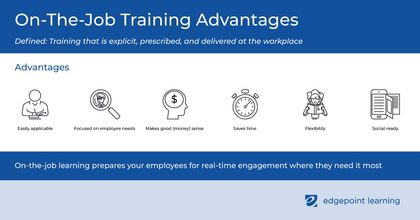What Are The Major On-The-Job Training Advantages?
Corey Bleich
🍿 4 min. read
Even the most experienced and educated employees still require training when they join your company. Maybe they just need to learn about the company culture or review the procedures your site uses. For employees and employers, on-the-job training is the best way to get up and running in the most efficient and effective way possible. Read on for its major advantages.
What do we mean by on-the-job training?
On-the-job training isn’t quite the same thing as learning by experience. Learning by experience is a simple concept that primarily occurs via mistakes. Maybe you try something one way, find it doesn’t work, then modify it until it does.
On-the-job training is a specific type of training that is explicit, prescribed, and delivered at the workplace.
For example, if you have a new intake nurse in your triage unit who needs to learn a specific computer program that your hospital uses, on-the-job training could use microlearning videos to deliver targeted information for that skill alone. Or, your sales team could use mobile resources to review product demos as they're waiting to enter a meeting.
The best on-the-job trainings are:
- Relevant
- Targeted
- Timely
- Helpful to employees
- Packed with useful information
Learning by experience may eventually be all of these things, but on-the-job training is a great way to help new employees learn procedures, programs, company culture, and other important concepts quickly.
What are the on-the-job training advantages that make it vital today?
The benefits of on the job training for employers and employees alike make it a better option than paying for conferences, guest speakers, or dodgy paper manuals that may just gather dust. No more sitting in windowless rooms for entire weeks of training. No more learning what does not apply or is not necessary.
On-the-job training delivered specifically through various microlearning modules is vital today because the advantages can’t be beat. The major advantages of on-the-job training include:
- Easily applicable
- It makes good (money) sense
- Saves time
- Gives you flexibility
- It's social-ready

Easily applicable
No more wasted time for employees paging their way through a dusty manual. No more scattershot approaches to designing training courses. On-the-job training is specific and focused on the needs of employees. If an employee needs to access a specific training module, they can use just-in-time online learning to locate courses they have already completed on their devices.
Employees will also appreciate the ability to get to important information quickly without paging through PowerPoint slides or calling multiple people in the company for help.
It makes good (money) sense
Employee training is one of the most expensive parts of onboarding. HR Onboard found that the average cost of onboarding a new employee can reach up to $40,000. In technology industries, that cost can soar even higher. But here’s the catch: these price tags do not even mention the cost of training.
Training costs include training rooms, travel, catering, and materials. Even if you cram your disgruntled employees into the conference room at the end of the hall for a day of presenters, those presenters cost money, and you lose a day’s worth of work from your employees.
Yes, it’s true that most (all?) employees wouldn’t turn down the opportunity to attend an expensive training conference in an exotic local, but you can’t really be sure of what they are getting (other than a good tan). For employees, once the tan lines fade, they may be left with a gap in knowledge that could reflect poorly in the work.
In the end, on-the-job training makes more sense for protecting the bottom line through ongoing and always-accessible resources. It may make sense to create a combined approach, but even then, you're still cutting overall costs of in-person training and travel.
Saves time
Time is a precious commodity for both employers and employees, and one of the best advantages of on-the-job training is that it delivers information when and where your employees need it most.
If your company is managing a large construction project that is under ever-changing codes and zoning laws, you can wrap that area in a geofence. Once employees pass into that area, a push notification lets them know if there are any changes they need to be aware of. This keeps you in compliance with the law, but it also shows employees that their time is valuable, too. No changes for the day? Then there’s no training needed.
A geofence can be set for as little as 250 feet, so it’s good for hospital or university complexes, too. This type of microlearning is an ultra-efficient and effective way to integrate on-the-job training into an employee’s day, making the best use of their time (and your resources).
Gives you flexibility
Your employees won’t need all of the information all of the time. They also won’t need it in the same format.
With many different types of eLearning tools available, you can choose the ones that make the best sense for you and your employees.
It's social-ready
Co-workers may be the best source of on-the-job training support, a practice that can help build good employee relationships.
If microlearning, geofencing, and other eLearning methods are experienced together in a social learning environment, co-workers get an opportunity to support each other through tricky concepts or challenging procedures.
So, what makes on-the-job training stand out?
If you are the person tasked with developing employee trainings, there is a strong case for eLearning when it comes to on-the-job training. Skills are learned where they will actually be applied, with tools that will actually be used. Often, on-the-job training uses real-time experiences combined with microlearning support to help employees go deeper.
This is not a drill; on-the-job learning prepares your employees for real-time engagement wherever they need it.
At EdgePoint Learning, we can help you figure out exactly what you want to accomplish with your on-the-job training, pairing those goals with training activities, online microlearning libraries, and real-world training opportunities across multiple platforms.
We look forward to helping you figure out what your needs are and which on-the-job training techniques work best to meet them. Get in touch today!
